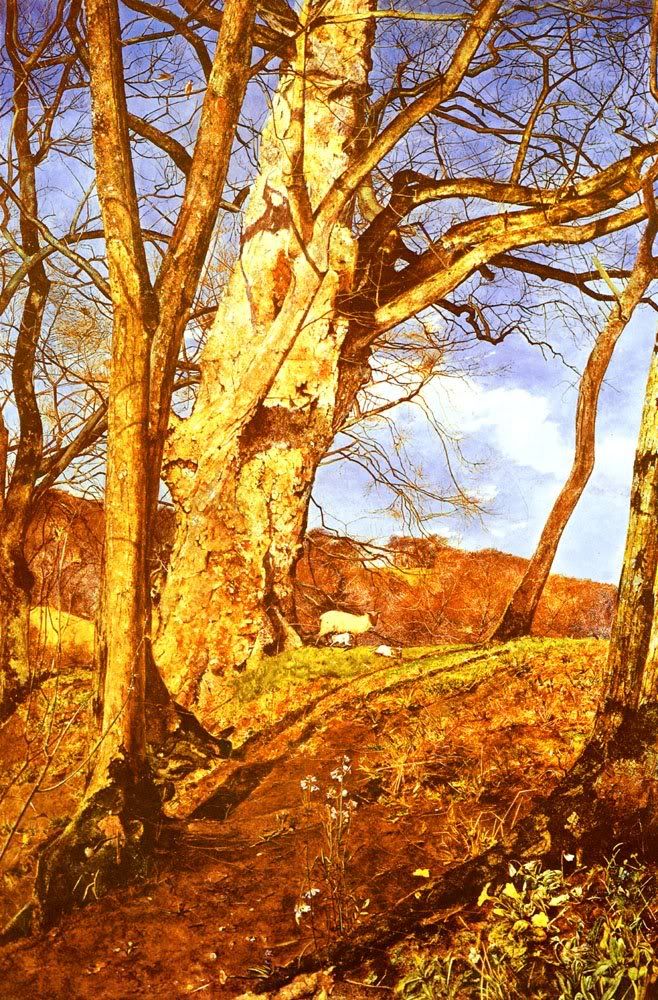
One of the most pleasurable things about writing this blog is that I'm constantly doing research. As a result, I often end up finding new artists that I'd never heard of before.
One of my recent discoveries is John William Inchbold, who painted A Study In March (In Early Spring)(shown above). A Study in March was inspired by William Wordsworth's poetry and was exhibited at the Royal Academy in 1855. The Spectator called it "a most delicious little piece—pure and perfect in its soft colour and unsurpassedly tender as a description of the season of early promise."
Inchbold's landscapes are extremely beautiful--(I've been looking everywhere for a copy of another of his paintings, The Chapel, Bolton ). It's a beautifully detailed rendering of Bolton Abbey done in the Pre-Raphaelite style. If anyone finds a public domain copy of the image on the web, let me know!
John William Inchbold grew up in Leeds, where his father worked in the newspaper business. John William left for London in 1846 in order to study lithography with the firm of Day & Haghe. Interestingly, while his obituary in The Athenaeum claims Inchbold studied at the Royal Academy, his name does not appear anywhere in their records, so if he studied with the Academy, it was in an unofficial capacity!
Inchbold showed his watercolours at the Society of British Artists in 1849 and 1850 and at the Royal Academy in 1851. In 1852 he met Dante Gabriel Rossetti and from that point onward his style changed dramatically. He began to draw heavily on the poems of Wordsworth, and his oil painting of the Chapel, Bolton (exhibited at the Royal Academy in 1853) shows Pre-Raphaelite influences, such as extreme attention to detail). The next year he produced another painting of Bolton Abbey, this time with a deer prominent in the foreground. Both paintings are based on William Wordsworth's poem "The White Doe of Ryleston."
Inchbold seems to have been a rather dull fellow (Rossetti complained that he was boring), at least in comparison to the rest of the Pre-Raphaelite Brotherhood, so that's probably why he's not as well known as his compatriots. At any rate, I think his paintings are just lovely.
Source consulted for Inchbold bio: Oxford Art Online
Image courtesy of Art Renewal International
Wednesday, August 20, 2008
John William Inchbold "In Early Spring"
Posted by
Margaret
at
11:20 AM
![]()
![]()
Labels: pre-raphaelites
Subscribe to:
Post Comments (Atom)


8 comments:
It makes sense that he was inspired by the poetry of Wordsworth. This looks like a Wordsworth poem come to life.
In my research for those dances I came across an absolutely amazing choreographer and will be posting about her dances soon!
Yes, I felt bad for that child; she didn't even know what she was dancing about!
You married a dancer? Can I say that the more I learn about you the more jealous I get! In a good way, of course.
Yes, I watch So You Think You Can Dance. I was definitely rooting for Katee and Joshua all the way!
Joshua actually grew up not to far away from me. I don't know that he and I ever met though. Sad day.
That painting is gorgeous. It makes me smile just looking at it!
I can almost smell that mud of early spring! And the ruggedness of the tree before the leaves come out. Love this painting by Inchbold. Nice post!
Wow. Great painting. I'm not familiar with Inchbold at all. Yay! You've given me someone else to learn about.
I'd not been aware of Inchbold before either! Always learn something new and great when coming here, Margaret--thanks! This painting is lovely...that sweet moment just before spring bursts forth! Happy Days ((HUGS))
I'm so glad I was able to find something new! I just love the light in the painting. It reminds me of those hours right before sunset, when the colours are just brilliant. The scene seems so familiar somehow. I feel like I've walked up that hill before myself! I think it's because it's so realistic, with the break between the hard-scrabble hillside dirt and the grass above.
Margaret: You get the BEST images...they are so lovely to contemplate and then to learn more about.
For those of you who would like to learn more about Pre-Raphaelite landscapes there is the excellent Pre-Raphaelite Vision catalogue from the Tate exhibition several years back.
Ah Rossetti thought Inchbold was dull...well compared to himself almost EVERYBODY else was. DGR was uniquely...NOT DULL.
Sorry to double dip here but as I looked at Inchbold's image it reminded me of a pilgrimage I made several years ago to the Watts Gallery in Compton, near Guildford.
It was a brilliant fall day and after visiting the Gallery I was directed to Mary Watts' Chapel up the road. WOW...it is within a cemetery at the top of a hill. The combination of art (both at the gallery and within the chapel) and nature that particular day made it one that I won't soon forget.
(I guess I should say that I live in Northern California where we don't experience dramatic changes of season so this perfect English countryside Fall day really impressed me.)
Post a Comment